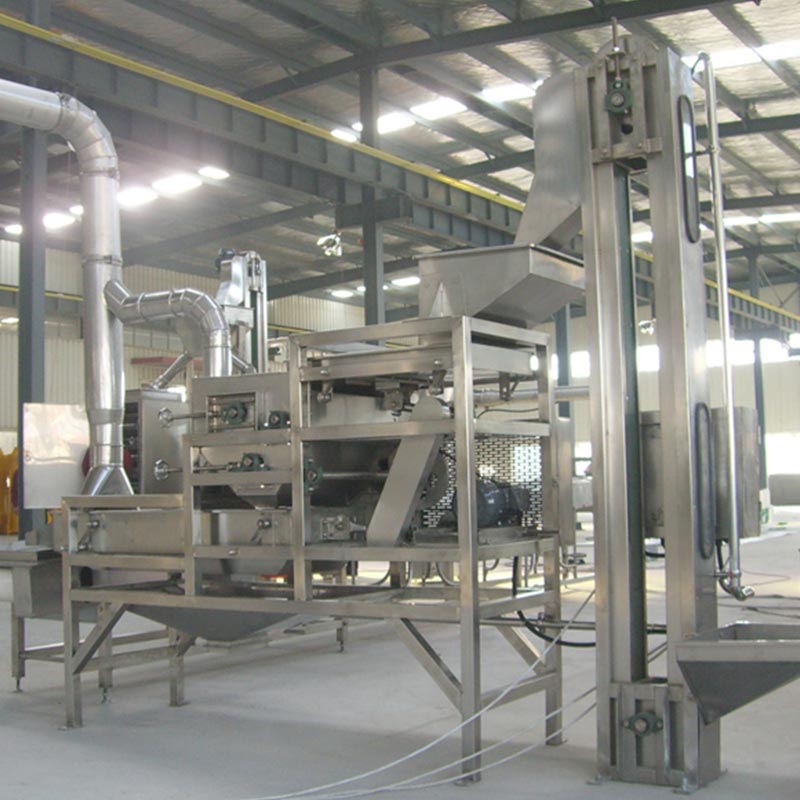

Spectrometric system
The system is based on the use of NIR (near infrared) energy as a means of excitation of the matter to be controlled, obtaining specific spectral information about it. This spectrum represents the absorption of the components present in the controlled product, such as Proteins, Water (moisture), Fats and Fibres.
These spectra are correlated with the concentration of the mentioned constituents through a mathematical model called Calibration. The systems developed by TecnoCientífica use the concept of transporting the light signal through special optical fibers, which ensure a transmission distance of up to 1000 meters with a maximum signal attenuation of 5%.
The main objective is the possibility of measuring remotely, independently of the distance, different points of the process line, concentrating all the information in a central unit, from which it can be managed by the different authorized operators.
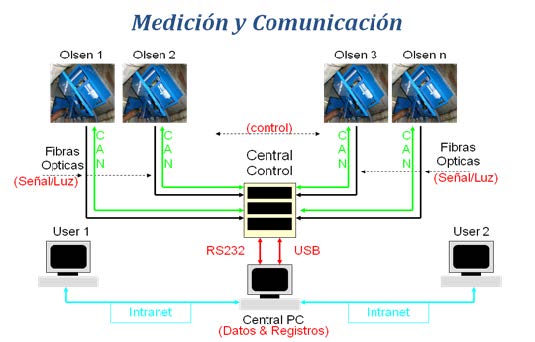

The information “On Line” and visual of the evolution of controlled parameters, can be observed by different actors, via Intranet or Internet, always under the strict control of the Administrator User generated by the client.
The products measured at the different points can be different and selectable at the user’s discretion. An exclusive and proprietary Fiber Optic Switching system is in charge of distributing the signal coming from the different sensors to the spectrometer unit, thus allowing the use of only 1 (one) spectrometer to control up to 10 remote measurement points with a single central unit. This gives the system an optimal cost/benefit ratio.
The technology designed by TecnoCientífica for the use of Real Time measurements and control in the process lines, focused on covering in the best possible way the user’s needs, keeping a wide versatility.
The heart of the central unit is a NIR spectrometric module with a PDA detector with up to 512 elements. PDA stands for Photo Diode Array and is often confused with CCD (Couple Charged Device).
Although the concept is similar, the material and type of components of the two arrangements are different. The diode array used by our technology utilizes InGaAs (Indo – Gallium – Arsenic Coated) elements considered the best, most stable components for detection in the near infrared (NIR) wavelength range.
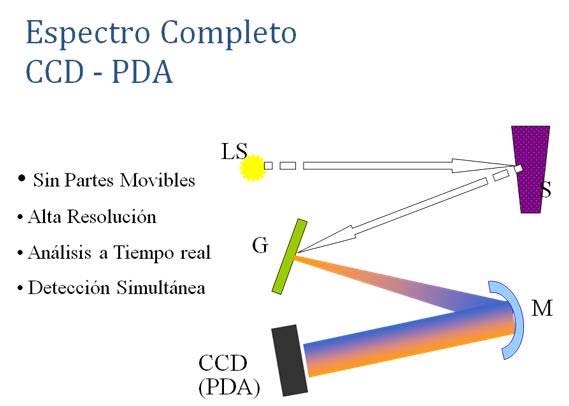

The main feature of this technology is not only that it obtains a FULL spectrum of the controlled product, but also that it is ultra-fast and collects ALL wavelengths simultaneously, making it IDEAL for On-Line determinations.
As there are no moving parts in the light scattering device, there are no drifts in its signal, and there is no need for optical calibration procedures of the spectrometer itself. This is an important difference from systems that use a monochromator to scan over all wavelengths in the NIR range.
In the monochrome system, higher resolution can be achieved, but the system MUST perform a full scan to obtain a complete spectral image of the product. Its detector is also an InGaAs Photodiode but only one component.
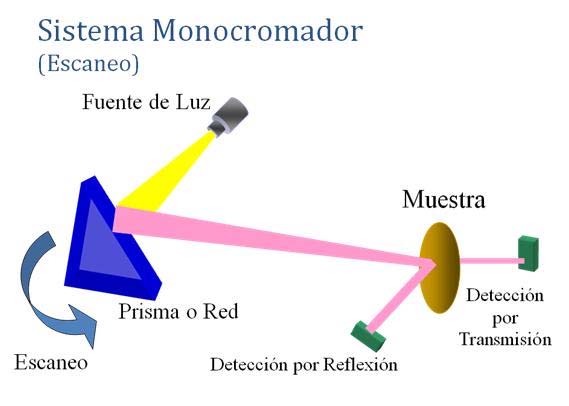

Therefore, to collect the complete image, it is necessary to move the dispersing element (prism or diffraction grating) in order to focus each portion of the spectrum on the single mono-detector. Thus, the measurement time is slower and the spectral image will actually correspond to a “diagonal” of the product, if it is to be applied in the process line, rather than a cross section of the product:
Experience has shown that for the handling of heterogeneous solids moving at high speed, the most important thing is the representativeness of the data.
The diode array technology (either PDA or CCD) allows us to obtain fast and complete information from the same sample section. But that has to be integrated with software management that allows the user to plot HOW MANY individuals they want to get before generating an integrated (or average) to get the prediction of the percentage composition of the sample.
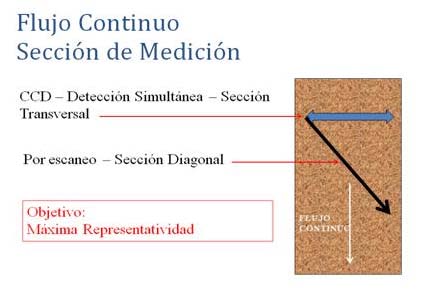

The software designed by TecnoCientífica allows the management and administration of this representativeness by the user. This means that, taking into account the production flow rate, the user can decide, by telling the software how many images to obtain before making a determination, how many kg corresponds to the representativeness of this data.
The oldest system used in NIR technology is the use of optical filters to obtain differentiated “bands” of light.
This type of technology is useful when you have a really homogeneous product, since we will only handle narrow and specific bands of wavelengths.
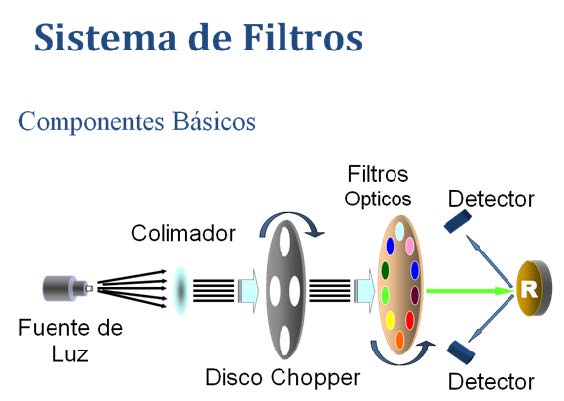

In addition, just as the monochromator must rotate the diffraction grating (or prism) to “sweep” the entire spectrum, in this technology, the filter disk must produce the full rotation to allow all the optical filters in the system to travel, giving each one enough time for a robust signal relative to the detector’s own noise.
Therefore the time is even shorter, and we would get an even more dispersed “diagonal” image.
In plants where product velocity and product heterogeneity is really high, this type of technology would be much more sensitive to product changes.
1) NIR unit completely isolated from the environment and thermally controlled by Peltier system:
Aware of the importance of environmental control for the spectrometric “heart”, the technology used by TecnoCientífica installs the NIR inside a thermo insulated from the environment (no dust ingress – no environmental humidity affectation) and controlled with a high power Peltier plate to maintain its micro environment at 20°C +/- 0.06°C. This gives the system excellent stability.
Systems that install spectrometers at each measurement point are exposed to extremely aggressive plant changes, in addition to adding much higher cost since each point is a spectrometer in itself.
2) Sensor WITHOUT contact with the Product:
With long experience in this type of plant, one discovers how aggressive and abrasive products such as soybeans and soybean meal can be when traveling at high speed.
To contact them would be to be permanently changing sensors.
Our systems measure through high hardness windows against which the sample is dragged, measuring continuously and without wear or fouling of any of the optical parts of the system.
Furthermore, we do not measure with “air chambers” between our sensors and the product to be monitored. That is, we do not place the sensors on the conveyor lines where there is an overhead distance between the sensor and the product. There are several reasons not to do so:
– As the belts move at very high speeds (due to the production volumes typical of this industry) air is blown into the sample changing its density.
– Also changes the distance between sample and sensor
– There is dust permanently in the lighting path which causes unwanted scattering.
– It is extremely difficult to control the contamination of the sensors.
In general, these technologies have been designed for the transport of more homogeneous products and for very low speed transports. It is very important to note that TecnoCientífica started its research and applications in this type of technology applied to heterogeneous and solid products in 2002, becoming pioneers in this field.
Its design is highly characteristic and differentiated, with great advantages for the openness of its system to the user, the management of several remote measuring points with a single spectrometer, different products and parameters.
1) Olsen remote measurement sensors:
– Fully assembled in dust-tight and moisture-proof industrial enclosures
– Optical sensor with tungsten halogen source and collimating lens included
– Automatic referencing system (Dark and White)
– High Hardness Quartz Crystal Window
– Automatic and programmable sampling system for calibration and/or validation.
– LCD display for status control and service
– Control electronics
– Inspection window for lamp status
– Sample container access hatch
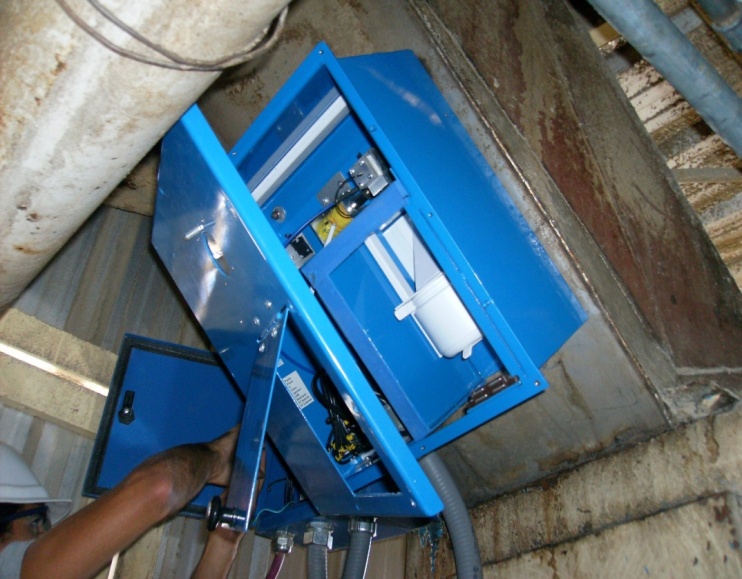

– General Electronics Box and Power Supplies for Olsen Sensor Precisa 220 volts stable and clean
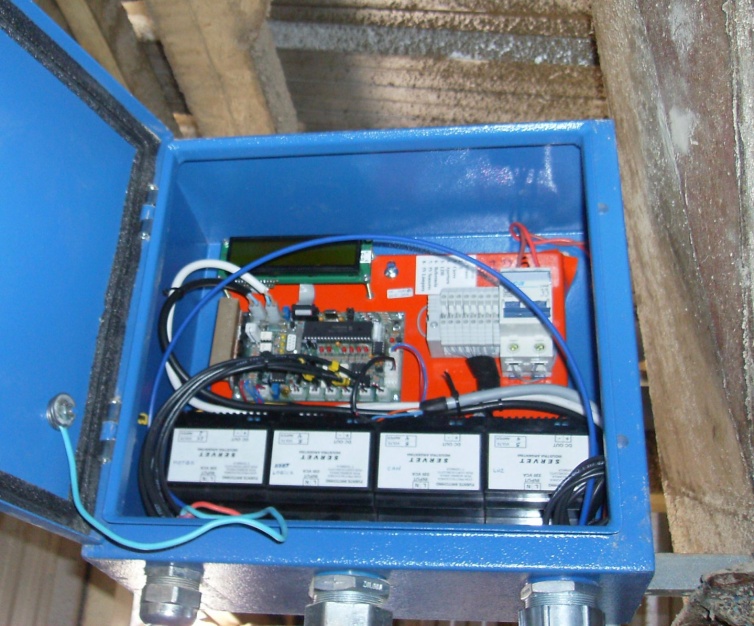

2) Automatic Control Center
Fully mounted in a special industrial rack to keep all electronics and spectrometer isolated from dust and humidity.
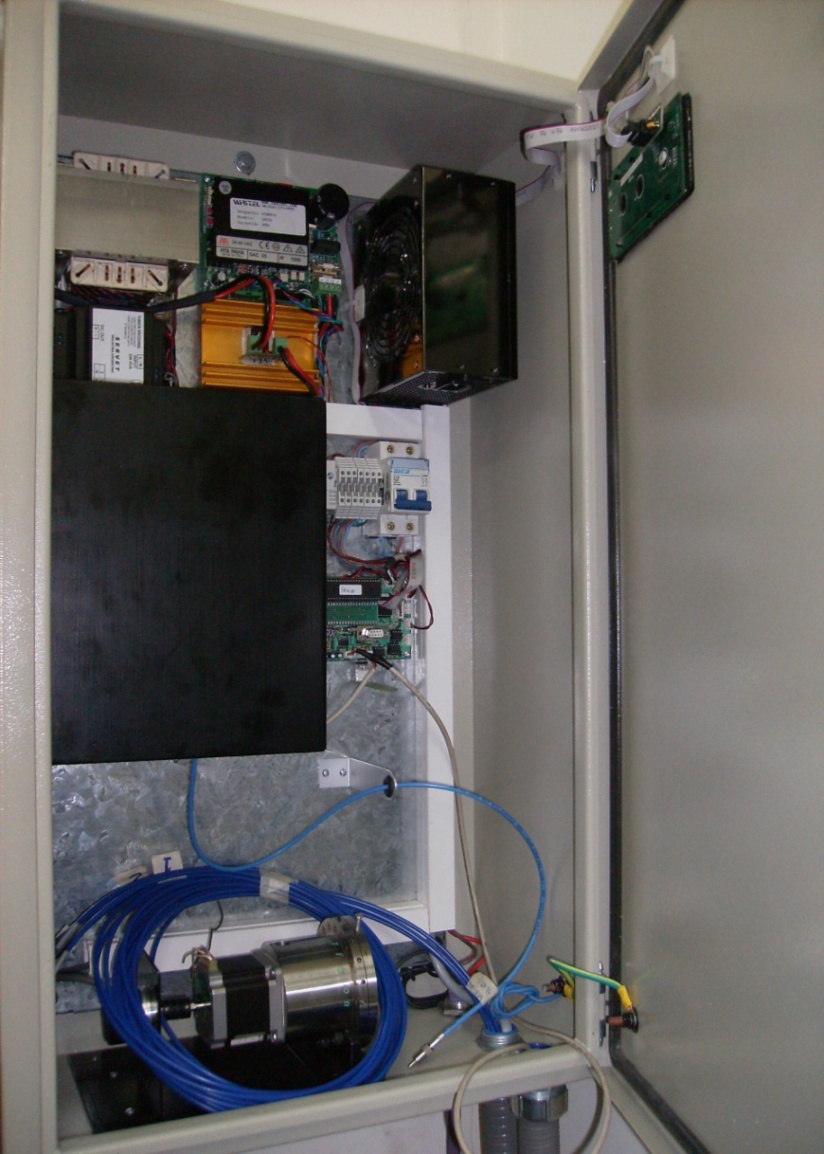

– NIR Spectrometric Unit mounted on TEC (Peltier) system that maintains its operating environment at 20°C +/- 0.1°C – Spectral range 1200 – 2100 nm. No air exchange with the external medium, so that no dust enters the spectrometer.
– Fiber Optic Switch, exclusive TecnoCientífica design, capable of handling up to 12 points sequentially.
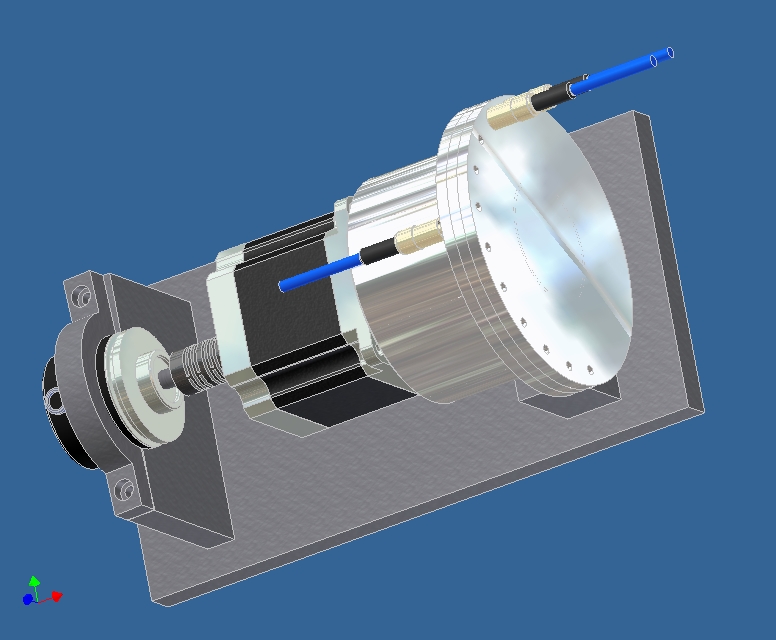

– General System Control Electronics
– Power supplies
– Communication control between sensors and PC
– LCD display for status control and service
3) Optical Fiber
– Diameter 400/500 microns
– Ultra Low OH Fused Silica Core (special for near infrared transmission)
– Internal protection with kevlar threads and plastic sleeve
– External protection with flexible PVC jacket
– Terminals with SMA Premium connectors
4) Communication:
Bus-Can communication protocol for the control of monitoring sensors at measuring points and automatic control units.
5) Monitoring Sensors:
Sensors are installed in all components of the system, which allow the operating status of all optical and mechanical parts to be monitored from the central PC:
– Presence of Sample Collection Bottle
– Lamp status
– Reference positioning
– Positioning of the sample gate
– Fiber Optic Switch Positioning
6) Central Operating Software
Designed and developed by TecnoCientífica, this software works under a Windows 2000, XP or higher platform, and commands the operation of data acquisition, screen display and storage. These are its main features and scope:
– Compatible with Windows 2000, XP or higher
– SQL Database, protected and inviolable
– Permanent and automatic historical records
– Export to Excel of historical data for selected periods at the user’s discretion.
– Configuration of Users and Passwords with different levels of access and operation, managed by the client’s Administrator user.
– On Line, automatic system operation
– Remote status monitoring of line sensors and their components
– Remote service and repair system for measuring points via software
– Display of data in individual graphs on the screen per measuring point (product) and parameter, as selected by the user. You can select to view all points & parameters or only the ones you want to view.
– User-selectable display period in graphics
– Automatic calculation of the average of the period shown in the graph, which is permanently updated with the last data taken.
– Current value (last measured), with its specific time
– Programming of critical levels for each parameter (maximum and minimum alarms).
– Production target line scheduling by parameter
– Individual setting tables per measuring point (product) and parameter
– Product configuration and calibrations per measurement point to be selected by the user. Changeable whenever required by the user, either by model updates, or by production changes in the different process lines where the sensors are located.
– Automatic archiving of spectra records (SPC) both measurement and those taken for validation/calibration.
– Possibility to install Slave Software for peripheral computers of users who need to visualize (only) the data On Line.
– Possibility of installation of Replication Software and remote command, if an administrator user needs to control, configure and/or adjust the system remotely.
– Programming of sampling for automatic validation/calibration at the different points, via software and from the central office.
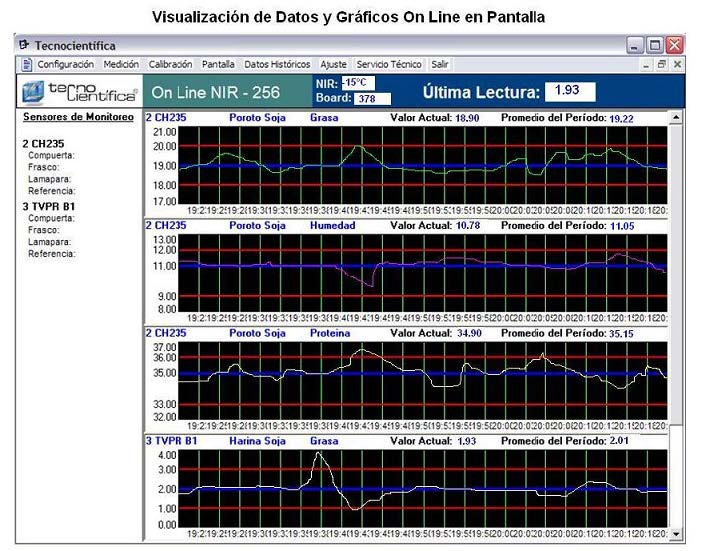

– All operation can be monitored, controlled and programmed from the Central Software.
– The system manages the measurement of all points sequentially, following the order established by the user. This sequence order can be modified upon request.
– Any of the measuring point(s) can be taken out of measurement by simply entering the configuration of the measuring point in question via the central software.
This may be because the line is out of production, or there is some maintenance work being carried out, or any other user requirement.
– The InLab NIR-512/256 line of benchtop instruments have the same technology as TecnoCientífica’s On-Line instruments, sharing the same concept of detection, spectral collection and composition prediction.
Será un placer para Nuestro Equipo asistirlo en la búsqueda de las Mejores Soluciones para su Proceso.
